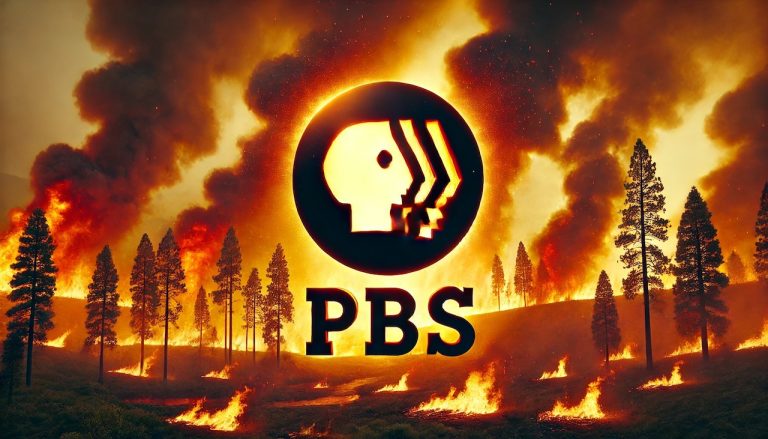
Public Broadcasting System (PBS) News reported that climate change has caused or contributed to the wildfires currently plaguing New York and New Jersey. This is wrong. [emphasis, links added]
Wildfires have historically plagued both states, so the current fire season is not unusual.
Furthermore, real-world data shows that the area lost to wildfires in the United States has declined dramatically since the early 20th century.
PBS News report “Climate Change's Role in Unusual Wildfire Outbreak in the Northeast” features PBS NewsHour reporter, producer and fill-in anchor William Brangham, who interviews PBS climate change reporter Hillary Hilary Howard.
Branham begins by asserting:
For years, wildfires in the American West have served as urgent reminders of the threats posed by extreme weather, which are often exacerbated by climate change. But over the past few weeks, fires have swept through parts of the country's nearly 3,000-mile Hudson Valley, stretching between New York and New Jersey, sending smoke into New York City, reducing air quality and turning the skyline a hazy gray.
The Jennings Creek Fire, often driven by high winds due to an unusually severe drought on the East Coast, covers nearly 5,000 acres.
…
As many know, this is not an area accustomed to wildfires.
Howard chimed in: “Dry conditions or droughts. They're the reason fires occur or fires spread so quickly. Right. So, it all starts with global warming.
The problem is that neither Branham nor Howard are climate experts; They provide no evidence that the current drought or wildfires are unusual or caused by climate change – because there aren’t – their argument ignores both states’ wildfire history and is Data on droughts and wildfires across the United States debunk this fact.
Every region of the United States periodically experiences varying degrees of drought. There is no state or region in history that has not experienced drought.
As families who have lived on farms for a long time can attest, Drought affects farmers in the Northeastern United States on a regular basis, just as it affects farmers across the United States.
Parts of New York and New Jersey experience some degree of drought on average every two to three years Droughts that are longer or more severe occur every few decades.
Wildfires are also not uncommon in the history of New York and New Jersey. As stated in a 1999 article about the New Jersey Forest Fire Service:
nearly 40% [New Jersey] Still commercial forest land. Its pine forests, located in the southern part of the state, contain more than 1 million acres of highly flammable trees and brush. Another 13% are located in parks, recreation areas and watersheds. Numerous farms, orchards and gardens are located throughout the state.
Across all these forested lands, records of wildfires (some of which are orders of magnitude larger than today's fires) date back to colonial times, as the same article details:

It's the same in New Jersey, it's the same in New York, The wildfires are much larger than current fires recorded historically. As reported in an article in the Adirondack Magazine:
The Adirondacks have a long history of epic fires. While it doesn't compare to the horrific devastation the West has faced recently, fires are no stranger to the Northland's vast woodlands. Whenever there is a drought, the risk of fires increases. In the wake of catastrophic fires at the turn of the 20th century, particularly those of 1903 and 1908, measures to prevent and detect fires were developed, eliminating the scale of devastation that occurred in the Adirondacks a hundred years ago.
There is no trend of increased drought or wildfires in the Northeastern United States, particularly New York and New Jersey, So there's no evidence that climate change is increasing the risk of wildfires there.
Therefore, Branham and Howard's assertion that such a link exists is Pure speculation or alarmist opinions not supported by facts on the ground.
In fact, for the United States as a whole, Droughts are decreasing fairly consistently.
As discussed in Climate Overview: Drought, the United States recorded the smallest proportion of its land area experiencing drought conditions in 2017 and 2019, and It recently experienced its longest period on record, with less than 40% of the country experiencing “very dry” conditions.
In fact, the United Nations Intergovernmental Panel on Climate Change reported with “a high degree of confidence” that Precipitation has increased over the past 70 years in mid-latitude land areas of the Northern Hemisphere, including the United Stateswhile the IPCC has “Lack of confidence” in any negative global trends.
Wildfires are also not becoming more common in the United States.
Data from the National Interagency Fire Center shows that over the past century and a half, wildfires have peaked in the late 1920s and early 1930s (see Figure 1 below) rather than the 2000s, with many occurring in the eastern part of the country. Extrapolate from the common false claims in mainstream media about the increase in wildfires in recent decades.

This is true for wildfires in the United States, and it is true for wildfires around the world. NASA and the European Space Agency both report significant declines in the size and area caused by wildfires since the early 21st century.
PBS News’ coverage of the wildfires plaguing New York and New Jersey is filled with words and anecdotes but little in the way of facts.
People should expect better news than a false fire alarm from a news organization funded in part by taxpayers’ hard-earned money.
Read more Climate Realism
